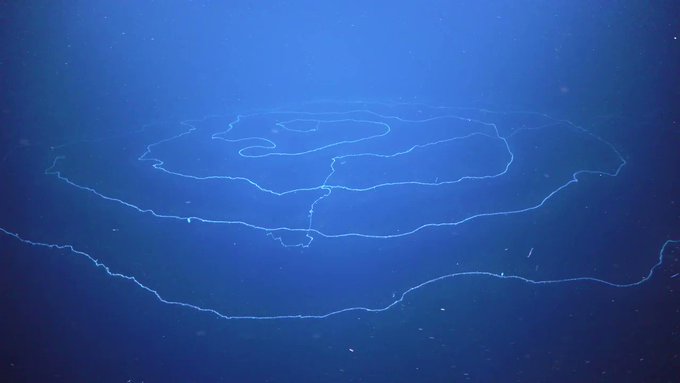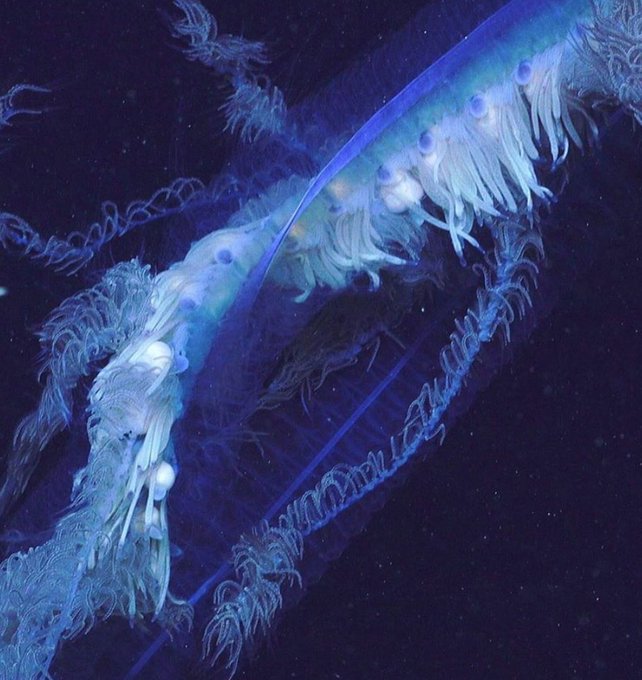According to an article published in the Science Alert, new footage has revealed a trailing ribbon of conjoined tentacled clones sweeping the ocean off the coast of Australia.
An Animal or A Collection of Animals?
Known in some regions as the “long stringy stingy thingy”, siphonophores blur the line between organ and organism. They somehow manage to be both at once.
“The whole thing looks like one animal, but it’s many thousands of individuals which form an entity on a higher level,” marine biologist Stefan Siebert of Brown University told Wired.
The Ningaloo Canyons Expedition, a team of international researchers from institutes including Western Australia Museum, Schmidt Ocean Institute and Scripps Institution of Oceanography, recently came across one of these spectacular deep sea aliens.
They were exploring a little-studied but biologically rich part of the ocean off the coast of Western Australia, using ROVs and sonar. The creature was spied on the way back up:
Check out this beautiful *giant* siphonophore Apolemia recorded on #NingalooCanyons expedition. It seems likely that this specimen is the largest ever recorded, and in strange UFO-like feeding posture. Thanks @Caseywdunn for info @wamuseum @GeoscienceAus @CurtinUni @Scripps_Ocean
Scientists Excited About the New Sighting
“Although the ROV pilots made an estimate of its length, it has yet to be formally measured. However, it does appear to be longer than any other animal on the planet,” they added.
Describing the Mysterious Animals
- The outer ring was estimated to be around 47 metres long (154 feet). The whole giant thing is composed of tiny individuals called zooids.
- They clone themselves thousands of times into one of several flavours – some with stinging tentacles and even red lures to attract food, others specialised for reproduction or movement. Each individual acts like an organ in the larger siphonophore body.
Biologist Rebecca Helm from the University of North Carolina Asheville describes the feeding clones on Twitter:
Some of the clones specialize in catching prey. Their slender bodies hang with a single long tentacle dangling like a hook-studded fishing line. Like the frilled tentacles of another siphonophore pictured below…
(pic: @SchmidtOcean https://bit.ly/2JLKWmS )
Why they are spread out like this?
The siphonophore in the video “appears to have assumed a planar feeding posture, which makes it look a bit like a spiral UFO,“ Wilson and Kirkendale explain.
In a colony this massive, there would have to be at least millions of these conjoined organ-individuals working together, to sift the pealgial depths for food. They share their spoils with each other by passing nutrients along a stem they’re all connected to – a vertical branch which also serves as a passageway for nerve signals.
Many More Out There?
Helm believes there are many millions of these siphonophores floating out there in the ocean, along with other strange creatures they interact with – such as this sea slug (Cephalopyge trematoides) that finds them tasty:
The sea slugs, called Cephalopyge, grab onto siphonophore clones using their tiny snail food and slowly eat them while hanging off the colony like an ornament!
Pic by: https://lindaiphotography.com/black-water-mollusks/ …
Another memeber of the entourage is this bizarre barreleye fish (Macropinna microstoma). It has a fluid-filled head shield thought to allow them to sneak into stinging tentacled zooids and steal their food.
It’s a soothing glimpse of the strange ocean depths that siphonophores call home. And you can check out even more amazing weirdos from the Ningaloo Canyons in the video below.
With so much incredible life hidden away in our planet’s oceans, who even needs aliens?
Did you subscribe to our daily newsletter?
It’s Free! Click here to Subscribe!
Source: Science Alert






























